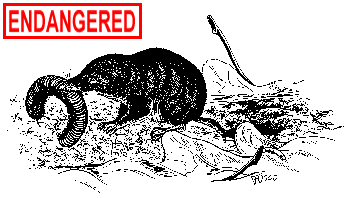Least Shrew
Cryptotis parva

Habitat: Open and dry grassy fields with woodland edges. In Connecticut, least shrews are only found in coastal areas with high beach dunes and adjacent brackish marshes.
Weight: 0.14-0.25 ounces.
Length: 2.7-3.5 inches, including the tail.
Life Expectancy: Less than 2 years of age.
Food: Insects, earthworms, snails, mollusks, amphibians, lizards, small mammals, carrion, and plant material.
Status: State endangered.
Identification: The least shrew is mole-like, with tiny eyes, inconspicuous ears, a long, pointed nose, velvety brown-gray fur, and the shortest tail of all the other shrews found in Connecticut. The fur is lighter in color during the summer months. Both sexes are similar in appearance.
Range: The least shrew occurs from coastal and southwestern Connecticut to central New York, west along the southern Great Lakes to South Dakota, and south to Florida, the Gulf of Mexico, central Texas, Mexico and Central America.
Reproduction: Least shrews reach sexual maturity at about 40 days of age and breed from early March to early November in Connecticut. The 2- to 5-inch wide nest is built in a shallow depression or burrow, commonly under stones, logs or stumps. It is made out of dry grass, leaves and finely shredded material. After a gestation period of about 15 days, 3 to 6 (average 4-5) young are born blind and naked. At birth, young shrews weigh only 0.11 ounces; however, they grow rapidly, often doubling their birth weight in only 4 days. Both adults care for the young, which are weaned at 21 days. Least shrews may have 2 to 3 litters per year.
Reason for Decline: The greatest threat facing Connecticut's least shrews is the development of coastal habitats, which results in the isolation of breeding populations. The chances for any individuals from these populations to move to other areas of suitable habitat may be limited or non-existent under these circumstances. Development also limits the amount of available habitat. Other threats include pesticides and pollutants that contaminate food and habitat.
History in Connecticut: The least shrew reaches the northern part of its range in coastal and southwestern Connecticut. In 1840, the species was first reported in Darien by Reverend James H. Linsley, who was better known for publishing bird lists. The species was not found again in Connecticut for 100 years. In 1941, George Goodwin, Assistant Curator of Mammals at the American Museum of Natural History, in New York, found one in Westbrook while walking along the edge of a saltgrass meadow. For almost 50 years since Goodwin's report, the secretive least shrew again remained unseen until one was found in coastal Middlesex County in 1989. Presently, this is the only documented Connecticut location of this species.
Interesting Facts: The least shrew was the first mammal listed as endangered under Connecticut's Endangered Species Act.
Shrews are classified as insectivores, not rodents. They are among the smallest of all living mammals. The least shrew is the smallest of the North American shrews and one of the smallest mammals found in Connecticut.
Least shrews have an extremely high metabolic rate. This rapid conversion of food to energy requires that these animals consume up to their own body weight in food every day.
The highly social and gregarious least shrew often cooperates in building burrows or nests, which are sometimes shared with other least shrews during the nesting and wintering seasons. The species uses the runways and burrows of moles, voles and other small mammals but will make its own runways in soft, loose soil. Tunnels under the snow provide protection from wind and intense cold, allowing least shrews to remain active all winter.
Least shrews rely mainly on their senses of touch and smell. Sight and hearing are not well developed.
Like Connecticut's other shrew species, the least shrew only lives a short time, usually a little over a year. After being born in the summer, shrews overwinter as juveniles, breed the following spring, raise 2 to 3 litters of young, and then die.
The size of the least shrew and its preferred habitat are reflected in historic names, such as little short-tailed shrew, little shrew and field shrew. Its genus name, Cryptotis, means "hidden ears" and its species name, parva, means "small."
Protective Legislation: State - Connecticut General Statutes Sec. 26-311.
What You Can Do: Support programs that protect or restore coastal dunes and marshes. Restricted development in areas adjacent to coastal marshes will help prevent further fragmentation of least shrew habitat and isolation of existing populations.

The production of this Endangered and Threatened Species Fact Sheet
Series is made possible by donations to the Endangered Species/Wildlife Income Tax
Checkoff Fund.
(rev. 12/99)

